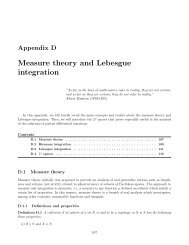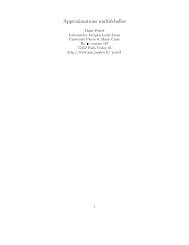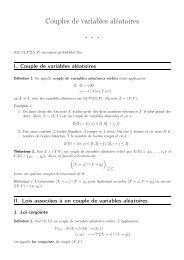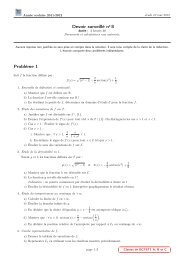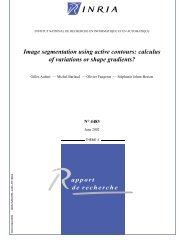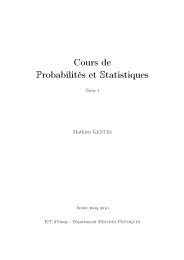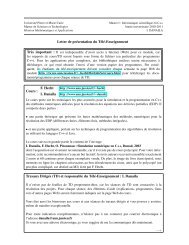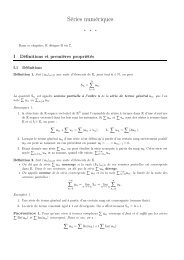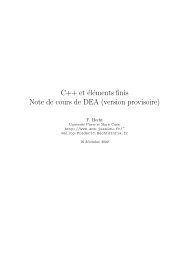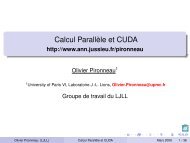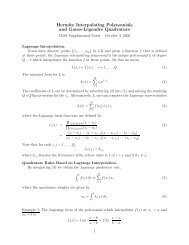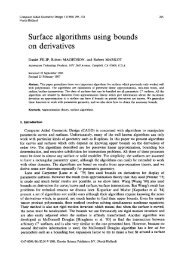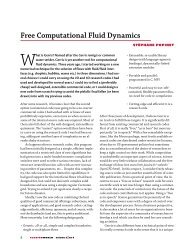Anisotropic Delaunay Mesh Adaptation for Unsteady Simulations
Anisotropic Delaunay Mesh Adaptation for Unsteady Simulations
Anisotropic Delaunay Mesh Adaptation for Unsteady Simulations
You also want an ePaper? Increase the reach of your titles
YUMPU automatically turns print PDFs into web optimized ePapers that Google loves.
<strong>Anisotropic</strong> <strong>Delaunay</strong> <strong>Mesh</strong> <strong>Adaptation</strong> <strong>for</strong><br />
<strong>Unsteady</strong> <strong>Simulations</strong><br />
C. Dobrzynski 1 and P. Frey 2,3<br />
1 IMB, UMR 5251, Université Bordeaux 1, 351 cours de la Libération,<br />
33405 Talence cedex, France and INRIA Futurs, Scalapplix team<br />
cecile.dobrzynski@math.u-bordeaux1.fr<br />
2 UPMC Univ Paris 06, UMR 7598, Laboratoire J.L. Lions, F-75005 Paris, France<br />
frey@ann.jussieu.fr<br />
3 Universidad de Chile, UMI 2807, Centro de Modelamiento Matemático,<br />
Santiago, Chile<br />
Summary. <strong>Anisotropic</strong> mesh adaptation is a key feature in many numerical simulations<br />
to capture the physical behavior of a complex phenomenon at a reasonable<br />
computational cost. It is a challenging problem, especially when dealing with time<br />
dependent and interface capturing or tracking problems. In this paper, we describe a<br />
local mesh adaptation method based on an extension of the <strong>Delaunay</strong> kernel <strong>for</strong> creating<br />
anisotropic mesh elements with respect to adequate metric tensors. In addition, we<br />
show that this approach can be successfully applied to deal with fluid-structure interaction<br />
problems where parts of the domain boundaries undergo large displacements.<br />
The accuracy and efficiency of the method is assessed on various numerical examples<br />
of complex three-dimensional simulations.<br />
1 Introduction<br />
In the context of numerical simulations based on variational methods, adaptive<br />
and anisotropic triangulations have proven to be very effective <strong>for</strong> solving complex<br />
physical and biomedical problems described by a set of partial differential<br />
equations; see <strong>for</strong> instance [19, 30, 32]. Actually, many applications (e.g., in solid<br />
and fluid dynamics, combustion, heat transfer, etc.) require localized regions of<br />
the computational domain to have alarger mesh density, i.e., closely-spaced vertexs,<br />
to capture the singular or nearly singular solutions that develop in such<br />
regions and to resolve large solution variations sufficiently accurately. Solving<br />
these equations with a uni<strong>for</strong>m mesh would require a huge number of mesh vertexs,<br />
often out of reach of the current computer technology. Indeed, the aim of<br />
mesh adaptation is twofold: improving the efficiency of the method <strong>for</strong> better<br />
accuracy and stability at a lower computational expense.<br />
On the other hand, dynamically evolving surfaces arise in numerous computational<br />
applications, such as free surfaces in multiphase flows or moving and de<strong>for</strong>ming<br />
interfaces in fluid-structure interactions, biomedical surfaces, etc. These<br />
applications require or involve potentially large displacements or de<strong>for</strong>mations<br />
of the domain geometry in time. Furthermore, this moving geometry is generally
178 C. Dobrzynski and P. Frey<br />
part of the solution of a set of partial differential equations and thus it is not<br />
known by or described by an analytical model. Such surfaces can be successfully<br />
handled by level set <strong>for</strong>mulations [29] or implicit surfaces. In many cases,<br />
it is again more efficient to use anisotropic elements and to adapt the mesh to<br />
capture the interface or to follow the severe de<strong>for</strong>mations of the geometry. The<br />
goal of this paper is to provide such mesh adaptation features <strong>for</strong> unstructured<br />
simplicial meshes in view oftime-dependent and geometry evolving simulations.<br />
In general, anisotropic mesh adaptation aims at equidistributing the approximation<br />
error by adjusting locally the mesh density according to a metric tensor<br />
field based on the Hessian of the numerical solution [16, 18]. It relies on the ability<br />
to control the size, the shape and the orientation of the mesh elements. In<br />
addition to improving the accuracy of the solution, anisotropy allows to preserve<br />
the order of convergence of the computational schemes [19]. It has already been<br />
largely shown that highly stretched mesh elements can interpolate a smooth<br />
function much more accurately than an isotropic mesh with regular elements<br />
[3, 33, 34]. As we will emphasize here, anisotropic elements also have the advantage<br />
of introducing regularity in the approximation of interfaces between<br />
physical domains.<br />
The contributions of this paper are the following. First, it provides a general<br />
context <strong>for</strong> anisotropic <strong>Delaunay</strong>-based mesh adaptation in three dimensions,<br />
based on a local point insertion procedure. In this respect, it can be considered<br />
as an extension of previous works on anisotropic meshing <strong>for</strong> complex domains<br />
[7, 9, 12, 13, 22, 32]. It can also be related to computational geometry results on<br />
<strong>Delaunay</strong> insertion of Steiner points in a triangulation, sometimes called point<br />
placement methods [11, 26]. However, here we provide a straight<strong>for</strong>ward andconvergent<br />
algorithm to locally adapt the mesh elements to any anisotropic metric<br />
tensor. Furthermore, we show how aslight modification of the <strong>Delaunay</strong> kernel<br />
allows us to prevent the generation of badly-shaped elements. Since our approach<br />
is based on local mesh modifications, the termination of the algorithm is straight<strong>for</strong>ward,<br />
although the resulting triangulation fulfill the <strong>Delaunay</strong> criterion only<br />
locally. Second, this paper explains how to build an anisotropic metric tensor <strong>for</strong><br />
level set interface tracking, following the ideas of [14]. Then, we show how this<br />
method can be efficiently used to resolve fluid-structure interactions and moving<br />
mesh problems where the computational domain geometry undergoes large<br />
displacements. We demonstrate benchmark and simulation results on rigid-body<br />
and on fluid dynamics simulations. For the sake of simplicity however, we will<br />
assume in all these simulations that the initial surface mesh is not concerned by<br />
adaptation. The local adaptation of surface meshes has been largely discussed in<br />
other papers over the last years (surveys can be found in [17, 27], <strong>for</strong> instance).<br />
The remainder of this paper is organized as follows. In Section 2,we review the<br />
main issues of anisotropic mesh adaptation based on Riemannian metric tensors.<br />
This notion of an anisotropic metric tensor has been described in a general<br />
purpose book [18] and in many research papers. In particular, we outline the<br />
definition of a metric tensor, the notion of metric intersection and interpolation.<br />
In Section 3, we show how the classical <strong>Delaunay</strong> mesh generation procedure can
<strong>Anisotropic</strong> <strong>Delaunay</strong> <strong>Mesh</strong> <strong>Adaptation</strong> <strong>for</strong> <strong>Unsteady</strong> <strong>Simulations</strong> 179<br />
be extended to the anisotropic context. In particular, we show how to compute<br />
the <strong>Delaunay</strong> kernel used <strong>for</strong> point insertion in the Bowyer-Watson approach to<br />
mesh generation. In Section 4, we describe our local mesh adaptation algorithm.<br />
Numerical examples of simulations are given in Section 5 to show the efficiency<br />
of the approach.<br />
2 Anisotropy and Metric Related Issues<br />
As pointed out already [18, 23], anisotropic meshing is closely related to differential<br />
geometry concepts and numerical error estimates.Here,we will briefly review<br />
the theoretical material (curvature estimates, metric tensor field, mesh quality)<br />
<strong>for</strong> anisotropic meshing strictly required to understand our approach, as it has<br />
already been thoroughly described in various papers [1, 3, 7, 12, 13, 15, 22, 19].<br />
2.1 Basic Definitions<br />
We introduce the following notations: Ω denotes a simply connected open<br />
bounded domain in R 3 , Ω is the closure of Ω and |Ω| is the d-dimensional measure<br />
or the volume of Ω. We suppose we are given acon<strong>for</strong>ming triangulation<br />
T h on Ω, h representing the characteristic element size. Each element K ∈ T h is<br />
aclosed subdomain of Ω and we assume that Ω = ⋃ K∈T h<br />
K and that the usual<br />
finite element requirements are satisfied (i.e., non-overlapping and intersecting<br />
elements are disallowed).<br />
A uni<strong>for</strong>m mesh of Ω is then a mesh in which all elements are equally-sized<br />
and regular. In such case, if |T h | represents the number of mesh elements and<br />
h K = diam(K) the diameter of K, the size h = max h K isgiven by the relation:<br />
K∈T h<br />
h K ≈<br />
( ) 1/d |Ω|<br />
∀ K ∈ T h .<br />
|T h |<br />
A quasi-uni<strong>for</strong>m mesh is a mesh <strong>for</strong> which (i) there exists a constant τ such that<br />
h K<br />
ρ K<br />
≤ τ ∀K ∈ ⋃ h<br />
where, <strong>for</strong> any open ball B i ⊂ K, ρ K = sup i {diam(B i )} is the in-diameter of<br />
K and (ii) the variation of h is bounded by aconstant. Notice that this notion<br />
does not assume a constant mesh size over the domain.<br />
T h ,<br />
2.2 Metric Tensors<br />
Essential to mesh adaptation is the ability to control the size, the shape and<br />
the orientation of mesh elements. This specification is usually based on an error<br />
estimate or an error indicator. Typically, it uses a matrix-valued field <strong>for</strong><br />
anisotropic mesh adaptation.
180 C. Dobrzynski and P. Frey<br />
On the continuous level, it is suitable to consider that mesh elements are<br />
represented by ellipsoids. In this geometric representation, the size of the element<br />
is its volume, the shape is associated with the ratio of the lengths of its semi-axes<br />
and the orientation is provided by its principal axis vectors. Then, their control<br />
can be achieved by specifiying a metric tensor M(x) to indicate the size, shape<br />
and orientation of mesh elements on the whole domain. Here, M(x) isa3 × 3<br />
symmetric positive definite matrix, sometimes referred to as a monitor function<br />
[23]. The function ρ(x) = √ det(M(x)) is called the adaptation function. This<br />
metric tensor is used to generate a quasi-uni<strong>for</strong>m mesh of Ω in the metric related<br />
to M. The volume of an element K ∈ T h isunitary:<br />
∫<br />
√<br />
∫<br />
det(M(x)) dx = ρ(x) dx =1, ∀K ∈ T h<br />
K<br />
and corresponds to the discrete <strong>for</strong>mulation:<br />
K<br />
|K| √ det(M K ) = 1 , ∀K ∈ T h ,<br />
where M K isan average of M(x) on K. By extension, the length of a curve γ in<br />
a metric M given by M(x) <strong>for</strong> any x ∈ Ω is defined as:<br />
|γ| M =<br />
∫ 1<br />
0<br />
√<br />
〈γ′ (t),M(γ(t))γ ′ (t)〉dt ,<br />
where γ(t) : [0, 1] → R d is a parametrization of γ. By analogy, the length of a<br />
mesh edge e is defined as:<br />
l M (e) =<br />
∫ 1<br />
0<br />
√<br />
et M(t)e dt .<br />
The edge length value represents also the number of subdivisions of the edge<br />
required to match the mesh size prescribed by the metric tensor. Since the metric<br />
tensor M(x) is supposed a symmetric positive definite matrix, the spectral<br />
decomposition theorem allows to decompose M as:<br />
M = P Λ P t =<br />
d∑<br />
λ i e i e t i ,<br />
where the normalized eigenvectors of M are the columns of matrix P =<br />
[e 1 ,...,e d ] such that PP t = P t P = I d and Λ is the diagonal matrix of the<br />
eigenvalues λ i = h i −1 ,where the h i are the sizes in each eigendirection. It is<br />
obvious to see that the matrix P prescribes the orientation, and the matrix Λ<br />
prescribes the size and shape of any element K.<br />
Metric intersection and interpolation<br />
Metric intersection<br />
Suppose that two metric tensors are specified at a vertex p ∈ T h . For mesh generation<br />
purposes, we would like to deal with a single metric at the vertex. To<br />
i=1
<strong>Anisotropic</strong> <strong>Delaunay</strong> <strong>Mesh</strong> <strong>Adaptation</strong> <strong>for</strong> <strong>Unsteady</strong> <strong>Simulations</strong> 181<br />
this end, we define a metric intersection procedure. Geometrically speaking, it<br />
consists in defining the largest ellipsoid E included in the intersection of the two<br />
ellipsoids E 1 and E 2 associated with the two metric tensors. From the algebraic<br />
point of view, we use the simutaneous reduction of the two underlying quadratic<br />
<strong>for</strong>ms to find a basis of the vector space in which the matrices M and N associated<br />
with E 1 and E 2 are represented respectively by I 3 and D, adiagonal<br />
matrix of M 3 (R).<br />
Denoting by P = ( e 1 e 2 e 3<br />
)<br />
the invertible matrix of GL3 (R) <strong>for</strong>med by the<br />
eigenvectors e i ,i=1, 3of the matrix N ′ = M −1 N leads to define the intersection<br />
matrix M ∩ as: M ∩ =(P t ) −1 ΛP −1 ,where Λ is the diagonal matrix with<br />
the coefficients max(λ i ,µ i ).<br />
Metric interpolation<br />
Consider a parametrization of a mesh edge pq as c : [0, 1] → R 3 , c(t) = (1−t)p+tq<br />
andtwo metric tensors M p and M q associated with the endpoints.We are looking<br />
<strong>for</strong> the metric tensor at t, hence <strong>for</strong> a matrix M(t) defined along the segment<br />
c(t) <strong>for</strong> any value of the parameter t ∈ [0, 1]. The definition of this matrix M(t)<br />
involves the interpolation of the eigenvalues of the matrices M p and M q .This<br />
procedure allows one to define acontinuous metric field along the segment. To<br />
this end, we suggest the following linear interpolation scheme:<br />
M(t) =<br />
(<br />
)<br />
(1 − t)M − 1 2<br />
p + tM − 1 −2<br />
2<br />
q , 0 ≤ t ≤ 1 . (1)<br />
Finding the interpolated metric tensor M t requires us to express the two matrices<br />
in a basis {e i } in which both are congruent to adiagonal matrix and then to<br />
deduce the metric tensor at point t. In other words, this scheme is similar to<br />
reducing simultaneously the two quadratic <strong>for</strong>ms associated with the metrics.<br />
2.3 <strong>Mesh</strong> Quality Measures<br />
There are several reasons <strong>for</strong> assessing a mesh and controlling its quality. In<br />
particular, it is useful to know if the mesh elements are aligned with the physical<br />
solution, especially in the anisotropic context. Then, in the adaptive context, it<br />
is important to know how closely the equiditribution and alignment conditions<br />
are satisfied by the mesh. Finally, in three dimensions, a quasi-uni<strong>for</strong>m mesh<br />
is not easy to produce if only controlling the lengths of mesh edges. It is well<br />
known that slivers (null volume) elements may occur and their creation cannot<br />
be prevented by simply checking the their edge lengths.<br />
The topics of mesh quality and mesh assessment have been studied in the<br />
context of finite element methods in numerous papers. We refer the reader to [2]<br />
and the references therein <strong>for</strong> more details on the related issues. Classicalquality<br />
measures include minimal angle condition [35] or maximal angle condition [4]<br />
as well as aspect ratio considerations. Other works include error estimates to<br />
account <strong>for</strong> the shape of the element and the solution behavior [6]. The adequacy
182 C. Dobrzynski and P. Frey<br />
between anisotropicelements and the anisotropyof the solution can be measured<br />
by a matching function [25].<br />
Given a metric tensor field M(x), it is natural to define critera to measure how<br />
closely the mesh elements are aligned and equidistributed with respect to M(x).<br />
For practical reasons, we introduce a single measure to evaluate the quality of<br />
an element K (given here in dimension d):<br />
〈e i ,M K e i 〉<br />
( k∑<br />
i=1<br />
Q ani (K) =α d<br />
|K| √ det(M K )<br />
where e i represents any of the k egdes of K and α d isanormalisation constant<br />
such that Q ani (K) = 1 <strong>for</strong> a regular element. Notice that Q ani ≥ 1 <strong>for</strong>all K ∈ T h<br />
and thus the larger max Q ani(K) is, the less the triangulation T h matches the<br />
K<br />
metric specifications. This quality measure is able to indicate how well a mesh<br />
element match the metric specification, both in terms of size (edge lengths) and<br />
of shape (aspect ratio).<br />
In addition, we define an efficiency index τ that provides a single scalar value<br />
to evaluate how well a mesh complies with the metric requirements:<br />
⎛<br />
⎞<br />
{<br />
∑<br />
lM (e i ) − 1if l M (e i ) < 1<br />
τ = exp ⎝ 1 ne<br />
1≤i≤ne<br />
l M (e i ) ⎠ , l M (e i )=<br />
) d<br />
,<br />
l −1<br />
M (e i) − 1<br />
and ne denotes the total number of mesh edges. The objective is to generate<br />
meshes <strong>for</strong> which the efficiency index isclose to the optimal value of one. In the<br />
simulations, a value τ ≥ 0.85 will be considered as an acceptable lower bound.<br />
else<br />
(2)<br />
2.4 Error Estimates<br />
A function e(h, u h ,f)is called an a posteriori error if it provides an upper bound<br />
on the approximation error: ‖u−u h ‖ W ≤ e(h, u h ,f). In the context of numerical<br />
simulations, the aim is toobtain an anisotropic bound where the physical derivatives<br />
are related to the size, the shape and the orientation of mesh elements. Research<br />
has been very active these recent years to develop mathematically-based<br />
error estimates and several references are provided in the bibliography section<br />
of this paper. From the numerical point of view, it is interesting toobtain estimates<br />
<strong>for</strong> the classical L 1 and L 2 norms or the H 1 seminorm. Such estimates<br />
have been provided <strong>for</strong> the interpolation error on linear Lagrange finite elements<br />
and involve the eigenvalues and eigenvectors of the Jacobian matrix of the affine<br />
mapping between the reference element and a mesh element [15, 31] or are based<br />
on the Hessian matrix of the solution [18, 1]. A local error model can be defined<br />
at a mesh vertex p as follows:<br />
e M (p) =<br />
d∑<br />
i=1<br />
h 2 i<br />
∂ 2 u<br />
∣ ∣ ,<br />
∂α 2 i
<strong>Anisotropic</strong> <strong>Delaunay</strong> <strong>Mesh</strong> <strong>Adaptation</strong> <strong>for</strong> <strong>Unsteady</strong> <strong>Simulations</strong> 183<br />
where the α i are the coefficients of the diagonal matrix Λ (see above) and the<br />
h i indicate the local sizes in the directions of the eigenvectors of the Hessian<br />
matrix. For our purposes, we define alocal error indicator the L ∞ norm as:<br />
e K = ‖u − P h u‖ ∞,K<br />
≤ C max<br />
y∈K max<br />
c⊂K 〈v, |D2 u(y)|v〉 ,<br />
where D 2 u represents the Hessian matrix of the function u and C is a constant<br />
independent of h.<br />
3 <strong>Anisotropic</strong> <strong>Delaunay</strong> <strong>Mesh</strong> <strong>Adaptation</strong><br />
Our approach suggests a modification of the classical point insertion procedure<br />
in a <strong>Delaunay</strong> triangulation to account <strong>for</strong> the anisotropic metric specifications.<br />
At first, we briefly recall the <strong>Delaunay</strong> kernel in the isotropic context, and then<br />
we introduce the modifications in the anisotropic context and <strong>for</strong> local mesh<br />
adaptation.<br />
3.1 The <strong>Delaunay</strong> Kernel<br />
In the classical isotropic context, mesh points are inserted in an existing <strong>Delaunay</strong><br />
triangulation using the so-called <strong>Delaunay</strong> kernel [18]. This incremental<br />
yet practical method provides an efficient means <strong>for</strong> constructing a<strong>Delaunay</strong><br />
triangulation.<br />
Theorem 1. (<strong>Delaunay</strong> kernel) Let T i be the <strong>Delaunay</strong> triangulation of the<br />
convex hull of a set of points S⊂ R d , and let p/∈S be a vertex enclosed in T i .<br />
The <strong>Delaunay</strong> kernel procedure can be written as:<br />
T i+1 = T i \C(p) +B(p) , (3)<br />
and provides T i+1 , a <strong>Delaunay</strong> triangulation of the convex hull of S ∪ {p}.<br />
The proof is obtained by duality with the Voronoï diagram and can be found in<br />
[21, 18]. In this fundamental result, C(p) stands <strong>for</strong> the cavity of point p: the set<br />
of simplices in T i such that their circumspheres contain point p and B(p) denotes<br />
the ball of point p: the set of simplices <strong>for</strong>med by joining p to the external faces<br />
of C(p). Practically, this result ensures that the cavity C(p) is a star-shaped<br />
polytope with respect to point p.<br />
However, in numerical simulations, at least two specific problems arise, related<br />
to the necessity of:<br />
i) inserting specific entities in the triangulations (a given set of edges defining<br />
the domain boundary, <strong>for</strong> instance) and<br />
ii) creating additionalvertices in the triangulation that are not part of the initial<br />
set S (<strong>for</strong> instance internal vertices during mesh adaptation).<br />
Regarding the last requirement, the following result provides the existence of a<br />
triangulation:
184 C. Dobrzynski and P. Frey<br />
Lemma 1. Let T i be an arbitrary triangulation and let p ∈ R d be a point enclosed<br />
in T i , p not being a vertex of T i . Then, a valid con<strong>for</strong>ming triangulation T i+1<br />
having p as vertex can be created using the <strong>Delaunay</strong> kernel, Theorem 1.<br />
The proof relies on the star-shaped character of the region C(p) with respect to<br />
point p [18]. This is only possible if the cavity is created incrementally from a<br />
seed tetrahedron (see above). Notice that due to this restriction, the resulting triangulation<br />
T i+1 may not be a <strong>Delaunay</strong> triangulation, although it is con<strong>for</strong>ming<br />
to finite elements requirements [10].<br />
Point insertion issues<br />
Defining the cavity C(p) ofapoint p requires identifying all simplices having<br />
acircumsphere that contains point p. The radius of the sphere circumscribed<br />
to asimplex K corresponds to the distance between any vertex p i of K and<br />
the circumcenter O of K: r K = d(p i ,O)=‖Op i ‖.The circumcenter O can be<br />
computed as the solution of alinear system of the <strong>for</strong>m:<br />
‖Op 1 ‖ = ‖Op i ‖ , ∀p i ∈ K , p i ≠ p 1 ,i= 2, . . . , d .<br />
Hence, given apoint p, an element K belongs to the cavity C(p) iff the following<br />
relation holds:<br />
α(p, K) = ‖Op‖<br />
r K<br />
< 1 ,<br />
where α(p, K) is the <strong>Delaunay</strong> measure of point p with respect to the simplex K.<br />
First,we haveto find the simplexor, in some peculiar cases, the set {K ∈ T h ,p∈<br />
K} of all simplices containing p the point to be inserted. Then, by incorporating<br />
all adjacent simplices K i such that α(p, K i ) < 1, the set C(p) is obtained. Each<br />
time a new simplex K i is added to C(p), the star-shapedness of this set is checked<br />
and the simplex iseventually removed if C(p) loses its property.<br />
In addition, to avoid the generation of badly-shaped elements like slivers,<br />
we introduced a minimal volume requirement: all new simplices obtained by<br />
connecting p to the external faces of C(p) must have a measure larger than a<br />
given lower bound: |K| >ε, with ε set to 1.10 −5 in the numerical experiments.<br />
This simple check has revealed especially and quite surprinsingly efficient in<br />
preventing the generation of most of the slivers, thus impacting favorably the<br />
optimization stage and the mesh quality histograms (cf. Section 4).<br />
3.2 <strong>Anisotropic</strong> <strong>Delaunay</strong> Kernel<br />
Asexpected, the extension to the anisotropic case consists of introducing a metric<br />
tensor, hence a symmetric positive definite matrix M p at each point p ∈ R d .This<br />
will allow us to consider the Euclidean norm of any vector in R d given the inner<br />
product 〈·, ·〉 M .Hence, all distance checks involved in the <strong>Delaunay</strong> measure will<br />
be replaced by length checks according to the given matrix M p ,namely:<br />
α Mp (p, K) = ‖Op‖ M P<br />
(r K ) Mp<br />
< 1 .
<strong>Anisotropic</strong> <strong>Delaunay</strong> <strong>Mesh</strong> <strong>Adaptation</strong> <strong>for</strong> <strong>Unsteady</strong> <strong>Simulations</strong> 185<br />
The <strong>Delaunay</strong> kernel (Theorem 1) relies on distance evaluations to define the<br />
cavity of the point p to be inserted in an existing <strong>Delaunay</strong> triangulation. Using<br />
the <strong>Delaunay</strong> measure α Mp ,it is possible to define avalid the cavity i.e., starshaped<br />
with respect to p. In [21, 18], we have the following result:<br />
Lemma 2 (anisotropic <strong>Delaunay</strong> kernel). Given a metric tensor M p at a<br />
point p ∈ R d , the anisotropic <strong>Delaunay</strong> measure, α Mp (p, K) < 1, provides a valid<br />
anisotropic <strong>Delaunay</strong> kernel.<br />
Again, the proof of the validity relies on the definition of a cavity, star-shaped<br />
with respect to p. Notice however that the resulting triangulation T i+1 may not<br />
be a <strong>Delaunay</strong> triangulation [26], but it is still con<strong>for</strong>ming to finite elements<br />
requirements. In this respect, this result provides a practical way of inserting a<br />
point in an anisotropic triangulation.<br />
Numerical issues<br />
Obviously, taking into account only the metric tensor at the given point p is not<br />
sufficientand accurate in many applications as the mesh elementsize may change<br />
rapidly from one point to another in space. There<strong>for</strong>e, we advocate considering<br />
all metric tensors related to the vertices ofelement K [20]. But doingso however,<br />
leads to solvinganonlinear system ofequations.The center O K of the topological<br />
sphere circumscribed to tetrahedron K = {p 1 ,...,p 4 } is the solution of a set of<br />
equations:<br />
l Mp (O K ,p 1 )=l Mp (O K ,p i ) i = 2, . . . , 4 ,<br />
where the length of the edge O K p i in the metric M p isgiven by:<br />
l Mp (O K ,p i )=2 m 12 (x i − O x )(y i − O y )+m 11 (x i − O x ) 2<br />
+ 2 m 13 (x i − O x )(z i − O z )+m 22 (y i − O y ) 2<br />
+ 2 m 23 (y i − O y )(z i − O z )+m 33 (z i − O z ) 2 ,<br />
with p i =(x i ,y i ,z i ) t , O K =(O x ,O y ,O z ) t , and M p =(m ij ) 1≤i,j≤3 . Finding the<br />
center O K simply leads to solving the following linear system:<br />
⎛<br />
⎝ a ⎞ ⎛<br />
2 b 2 c 2<br />
a 3 b 3 c 3<br />
⎠ ⎝ O ⎞ ⎛<br />
x<br />
O y<br />
⎠ = ⎝ d ⎞<br />
1<br />
d 2<br />
⎠ ,<br />
a 4 b 4 c 4 O z d 3<br />
with the coefficients:<br />
a i = 2 (m 11 (x i − x 1 )+m 12 (y i − y 1 )+m 13 (z i − z 1 )),<br />
b i = 2 (m 22 (y i − y 1 )+m 12 (x i − x 1 )+m 23 (z i − z 1 )),<br />
c i = 2 (m 33 (z i − z 1 )+m 13 (x i − x 1 )+m 23 (y i − y 1 )),<br />
d i = m 11 x 2 i + 2 m 12 x i y i + 2 m 13 x i z i + m 22 y 2 i + 2 m 23 y i z i + m 33 z 2 i<br />
−(m 11 x 2 1 + 2 m 12 x 1 y 1 + 2 m 13 x 1 z 1 + m 22 y 2 1 + 2 m 23 y 1 z 1 + m 33 z 2 1).<br />
Furthermore, numerical experiments revealed that it is interesting to account<br />
<strong>for</strong> all metric tensors at the vertices p i in order to define the cavity. We found<br />
efficient to assess the cavity with two inequalities:
186 C. Dobrzynski and P. Frey<br />
⎧<br />
⎪⎨<br />
⎪⎩<br />
α Mp (p, K) < 1,<br />
4∑<br />
α Mpi (p, K)+α Mp (p, K) < 5.<br />
i=1<br />
(4)<br />
Like in the generic case, weavoided the creation of most slivers by introducing<br />
a minimal volume requirement |K| >ε, the measure of the element being<br />
computed in the relevant metric.<br />
4 Local <strong>Anisotropic</strong> <strong>Mesh</strong> <strong>Adaptation</strong><br />
Adaptive meshing methods belongto one oftwo categories depending on whether<br />
they proceed by global or local remeshing of the computational domain at each<br />
iteration. Global remeshing techniques consist in constructing anew mesh of<br />
the domain at each iteration, to ensure that the elements are in good agreement<br />
with the anisotropic metric-related prescriptions. The latter are supplied at the<br />
vertices of the previous mesh that is then acting as a control space. Obviously,<br />
the order of complexity of the meshing method remains the same throughout the<br />
whole adaptation scheme. In steady-state adaptative simulations, the number of<br />
modifications usually decreases with the iterations since a fixed point of the<br />
pair (mesh,solution) is targeted. In other words, once mesh features have been<br />
identified and captured by adjusting the local vertex density, numerical accuracy<br />
is only a matter of introducing a few more vertexs in critical regions while most<br />
of the mesh is kept unchanged. Hence, remeshing at each iteration the whole<br />
domain results in a loss of efficiency (even if improvements have been proposed<br />
[9, 19]). It seems more advantageous that fewer vertices are inserted in critical<br />
regions over time, as this will help to minimize the run time of the algorithm<br />
while at the same time converging to asolution. Hence, in our approach, we<br />
per<strong>for</strong>m local mesh modifications.<br />
4.1 <strong>Mesh</strong> Modification Operations<br />
<strong>Mesh</strong> modification are either geometrical (edge split, edge collapse, vertex relocation)<br />
or topological (edge flip). In the anisotropic context, we assume that a<br />
metric tensor field is provided at the mesh vertices of a given triangulation. The<br />
objective is then to modify this triangulation iteratively by local operations in<br />
order to obtain a quasi-uni<strong>for</strong>m triangulation wih respect to this field. An important<br />
feature consists in modifying the metric specifications to account <strong>for</strong> a<br />
desirable (i.e., user-specified) mesh gradation. This procedure is fully described<br />
in [8] and is used here as such.<br />
Our approach is based on the analysis of the edge lengths. Given a metric field<br />
prescription, all mesh edges have to belong to the interval [l min ,l max ] and the<br />
mesh element quality has to be close to the optimal unit value. Theoretically,<br />
a quasi-uni<strong>for</strong>m triangulation is characterized by the fact that all edges have<br />
aunit length, i.e., l min = l max = 1. However, it is easy to understand that<br />
such restriction is highly improbable and we suggest to set the lower and upper
<strong>Anisotropic</strong> <strong>Delaunay</strong> <strong>Mesh</strong> <strong>Adaptation</strong> <strong>for</strong> <strong>Unsteady</strong> <strong>Simulations</strong> 187<br />
bounds of the edge lengths to the values l min = √ 2 −1 and l max = √ 2. All local<br />
mesh modifications can be simulated in order to check whether the resulting<br />
configuration is better than the previous one. Aconfiguration is considered as<br />
improved if the mesh quality ofall the elements involved is better (or almost<br />
identical in the case of an edge collapse) than the original configuration.<br />
Short edges l M (e) l max are normally removed by splitting them into unit<br />
subsegments with respect to the metric specification. This consists in introducing<br />
the new vertices using the anisotropic <strong>Delaunay</strong> kernel. The main advantage<br />
of this approach is that the set of elements concerned by the vertex insertion<br />
(the cavity) is usually much larger than the set of elements strictly surrounding<br />
the edge (the initial cavity). Computationally, it revealed more efficient to<br />
proceed like this and the quality of the resulting mesh is better than with the<br />
classical edge split operation. Furthermore, the creation of slivers is explicitely<br />
checked and prevented during this stage. Sometimes, in peculiar cases, an edge<br />
flip operation can be used to remove along edge.<br />
In addition, a mesh optimization stage involves a vertex relocation procedure.<br />
This procedure aims at equidistributing the edge lengths, with the objective of<br />
improving the efficiency index. Given a mesh vertex p, the objective is toimprove<br />
the lengths of all edges connected to p. To this end, the vertex ismoved in<br />
the direction of anoptimal vertex location corresponding to the average optimal<br />
positions along each edge. This operation does not affect the mesh topology,<br />
nonetheless optimal vertex positions have to be checked to prevent invalid configurations.<br />
All mesh modification operations are described in details in the general purpose<br />
book [18].<br />
4.2 <strong>Mesh</strong> <strong>Adaptation</strong> Scheme<br />
Our mesh adaptation algorithm can then be described as follows: we assume<br />
given a triangulation T and a metric tensor field M defined at the mesh vertices,<br />
En<strong>for</strong>ce the desired h-gradation,<br />
do<br />
1. loop over mesh edges /* edge analysis */<br />
compute l M (e) <strong>for</strong> every edge e<br />
if (l M (e) l max ) then
188 C. Dobrzynski and P. Frey<br />
split e and insert new vertex (<strong>Delaunay</strong> kernel)<br />
endif<br />
while ( T is modified )<br />
2. loop over mesh elements /* quality optimization */<br />
per<strong>for</strong>m edge flips<br />
per<strong>for</strong>m vertex relocation<br />
end <strong>for</strong><br />
while ( triangulation T is modified ).<br />
Notice that this algorithm (composed of two levels of imbricated loops) always<br />
terminates in a finite number of iterations. Indeed, mesh modifications are<br />
only applied if they result in the mesh quality improvement. An infinite loop<br />
could potentially occurs between several configurations if the analysis is based<br />
on the edge lengths only. For instance, if the values of l min and l max are too<br />
close, the edge split and the edge collapse operations could possibly lead to a<br />
previous configuration. However, since we apply the mesh modification if the<br />
quality is strictly improved, this case cannot happen in our scheme. In addition,<br />
<strong>for</strong> efficiency purposes, we have restricted the overall number of iterations to a<br />
maximum value.<br />
The complexity of the algorithm is related to the number of loops that are<br />
per<strong>for</strong>med. The inner loops are in O(nt), where nt is the number of mesh elements.<br />
Since we limit the nmber of outer loop to a maximum value c, the overall<br />
complexity is cO(nt), i.e., linear in number of mesh elements.<br />
4.3 Application to Large Displacements Problems<br />
As pointed out in the introduction, our local anisotropic mesh adaptation approach<br />
allows us to handle rigid-body displacement problems without difficulty.<br />
Fluid-structure interactions involves a moving structure, rigid or de<strong>for</strong>mable,<br />
and afluid in flow around a part or the whole structure. The domain boundary<br />
is moving, however moving only boundary vertices would quickly result in an<br />
invalid mesh. There<strong>for</strong>e, internal vertices are also relocated using alinear elasticity<br />
analogy [5]. Actually, the whole procedure is straight<strong>for</strong>ward and can be<br />
decomposed in three successive stages: given a field of displacements prescribed<br />
at the domain boundaries, e.g., resulting from afluid calculation, (i) solve alinear<br />
elasticity equation as suggested by [5] to define adiscrete displacement field<br />
at all mesh vertices and (ii) move the mesh vertices to the positions prescribed<br />
by this field and (iii) optimize the resulting mesh.<br />
This boundary value problem assumes that part of the boundary remains<br />
fixed as another part is moving. It reads:<br />
⎧<br />
⎨ −divσ(u) =f in Ω<br />
u = 0 on Γ fixed<br />
⎩<br />
σ(u) · n = 0 on ∂Ω\Γ fixed
<strong>Anisotropic</strong> <strong>Delaunay</strong> <strong>Mesh</strong> <strong>Adaptation</strong> <strong>for</strong> <strong>Unsteady</strong> <strong>Simulations</strong> 189<br />
and the Hook’s law gives the relation between the stress tensor σ and the linearized<br />
strain tensor e as: σ = 2µe(u)+λtr(e(u))I 3 , with e(u) = 1 2 (∇u+∇ut ),<br />
λ and µ are the Lamé coefficients describing the mechanical properties of the<br />
material. The variational <strong>for</strong>mulation is solved using affine P 1 Lagrange finite<br />
elements. The Lamé coefficients have been set experimentally in our simulations.<br />
The linear system is solved using a conjugate gradient routine with a LDL t preconditioning<br />
step. The convergence of the linear system is not affected too much<br />
by the anisotropy of the mesh, indicating that the condition number does not<br />
degrade too much with the anisotropy.<br />
Notice that our approach preserves the number of mesh vertices during this<br />
stage and involves vertex relocation and edge flips only. However, edge splits and<br />
edge colapses can also be used to achieve a better efficiency in large displacement<br />
problems.<br />
5 Application Examples<br />
Our approach has been tested on numerous test cases and is currently used by<br />
several research groups. We provide here a set of numerical examples to assess<br />
this method.<br />
5.1 An Analytical Metric<br />
This first test case is provided to illustrate our mesh adaptation scheme on a<br />
steady-state problem where the size, the shape and the orientation of the mesh<br />
elements are prescribed using the following analytical metric:<br />
⎛<br />
⎞<br />
M = ⎝ h−2 1 0 0 {<br />
0 h −2<br />
max 0 ⎠ h1 = h<br />
with<br />
max |1 − e −|x−0.5| | +0.003<br />
(5)<br />
0 0 h −2<br />
h max =0.2<br />
max<br />
This metricsimulates the capture of a planar shock in the computational domain:<br />
Ω =[−1 , 1] 3 .We started with an initial surface-adapted mesh T 0 containing no<br />
internal vertex containing 4, 399 vertices and 13, 978 tetrahedra (Figure 1). The<br />
final adapted mesh after 5iterationscontains 51, 440 tetrahedra and its efficiency<br />
index is 0.87. Regarding the mesh quality, 99.96 percents of the elements have a<br />
quality measure between 1and 3.<br />
5.2 Interface Capturing<br />
Our approach has also proven useful in accurately tracking and approximating<br />
adynamically evolving interface [14]. In this approach, the metric tensor field<br />
is related to the intrinsic properties of the manifold of codimension one that<br />
correspond to the interface. We consider an implicitly-defined, scalar valued<br />
function u on adomain Ω ⊂ R 3 and we denote by Γ the surface associated<br />
to the isovalue u = 0. The objective is to produce a mesh where the density
190 C. Dobrzynski and P. Frey<br />
Fig. 1. Initial surface-adapted mesh (left), cut though the final adapted mesh (middle)<br />
and local enlargment (right)<br />
Fig. 2. Example of mesh adaptation to capture an implicitly defined surface: cutting<br />
plane through tetrahedral elements (left) and isosurface reconstruction (right)<br />
is high in the vicinity of the isosurface so as to minimize the piecewise affine<br />
approximation of this interface. To this end, we defined the following metric<br />
tensor at the vertices of all mesh elements intersected by the manifold:<br />
⎛<br />
⎞<br />
M = R ⎝ 1/ε2 0 0<br />
0 |λ 2 |/ε 0 ⎠ t R,<br />
0 0 |λ 3 |/ε<br />
with R = ( ∇uv1 v2 ) ,where (v 1 ,v 2 )is a basis of the tangent plane to the<br />
surface and λ i are the eigenvalues of the Hessian of u. Atall other vertices, we<br />
define the metric αI 3 with α ∈ R + .Weconsider the analytical surface defined in<br />
spherical coordinates as: r =0.45+0.3 sin(3φ), with θ ∈ [0; 2π] and φ ∈ [− π 2 ; π 2 ].<br />
We started from an initial uni<strong>for</strong>m mesh of size h =0.2 (Figure 2). The final<br />
mesh after 8 iterationscontains 10 5 vertices <strong>for</strong> a minimal elementsize h = 10 −3 .<br />
The approximation error in the L ∞ norm between the surface and its piecewise<br />
affine discretization is lesser than 10 −4 .
<strong>Anisotropic</strong> <strong>Delaunay</strong> <strong>Mesh</strong> <strong>Adaptation</strong> <strong>for</strong> <strong>Unsteady</strong> <strong>Simulations</strong> 191<br />
Fig. 3. Two moving spheres are crossing an anisotropic field<br />
5.3 Moving Spheres in <strong>Anisotropic</strong> Field<br />
We consider two spheres of different radii moving in acomputational domain<br />
Ω =[−2 , 2] × [−2 , 6] × [−10 , 1.5] (Figure 3). The initial mesh is adapted to a<br />
planar shock corresponding to a metric specification very similar to that given<br />
by Equation (5). The main difficulty isto preserve the anisotropic refinement<br />
throughout the simulation. To this end, we have allowed edge split and edge<br />
collapse operations in addition to vertex relocation and edge flips. Nevertheless,<br />
the number of vertices remains almost constant: 12, 200 <strong>for</strong> he inital mesh and<br />
11, 282 at the 34th time step. The efficiency index isalso constant τ =0.86.<br />
5.4 Airflow around a Rotating Helicopter Propeller<br />
The flow is governed by the classical compressible Euler equations of the fluid<br />
dynamics and the numerical resolution uses the software Fluidbox based on<br />
finite volume and Arbitrary Lagrangian Eulerian (ALE) method [28] that imposes<br />
a constant number of vertices and the connectivity to remains identical<br />
to that of the initial mesh. The solver uses implicit time stepping scheme. Furthermore,<br />
weconsider that the propeller turns with a constant angular velocity<br />
θ =3.6deg, i.e., 10 full rotations per second. One mesh is generated at each time<br />
step dt =1/6, 000 seconds and 100 meshes are needed to achieve a complete revolution.<br />
However, the constant topology and number of vertices constraints have<br />
been relaxed: a few edge flips were introduced to remove badly-shaped elements<br />
and the solution had then to be interpolated on the optimized mesh (Figure 4).<br />
All meshes contain about 3.10 5 elements <strong>for</strong> an efficiency index close to 0.85<br />
(more than 98 percent of the elements have aquality better than 3).
192 C. Dobrzynski and P. Frey<br />
Fig. 4. Airflow simulation: adapted meshes at iterations 1, 99 and 500 (top); streamlines<br />
and velocity modulus (bottom)<br />
6 Conclusions and Perspectives<br />
In this paper, we have presented an efficient method <strong>for</strong> obtaining anisotropic<br />
adapted meshes based on Riemannian metric specifications. This approach is<br />
based on amodification of the classical <strong>Delaunay</strong> kernel and involve local mesh<br />
modification operations. The results obtained so far in the numerical simulations<br />
are promising and confirm the cogency of the local modification strategy.<br />
The next stage will be to handle dynamically evolving domains where both the<br />
geometry and the topology of the domains change in time.<br />
References<br />
1. Alauzet, F., Loseille, A., Dervieux, A., Frey, P.: Multi-dimensional continuous metric<br />
<strong>for</strong> mesh adaptation. In: Proc. 15th Int. <strong>Mesh</strong>ing Roundtable, pp. 191–214<br />
(2006)<br />
2. Apel, T., Berzins, M., Jimack, P.K., Kunert, G., Plaks, A., Tsukerman, I., Walkley,<br />
M.: <strong>Mesh</strong> shape and anisotropic elements: Theory and practice. In: Whiteman,<br />
J.R. (ed.) The Mathematics of Finite Elements and Applications X, pp. 367–376.<br />
Elsevier, Ox<strong>for</strong>d (2000)
<strong>Anisotropic</strong> <strong>Delaunay</strong> <strong>Mesh</strong> <strong>Adaptation</strong> <strong>for</strong> <strong>Unsteady</strong> <strong>Simulations</strong> 193<br />
3. DAzevedo, E.F., Simpson, R.B.: On optimal triangular meshes <strong>for</strong> minimizing the<br />
gradient error. Numer. Math. 59, 321–348 (1991)<br />
4. Babuška, I., Aziz, A.K.: On the angle condition in the finite element method. SIAM<br />
J. Numer. Anal. 13, 214–226 (1976)<br />
5. Baker, T.J.: <strong>Mesh</strong> Movement and Metamorphosis. Eng. Comput. 18(3), 188–198<br />
(2002)<br />
6. Berzins, M.: A solution-based triangular and tetrahedral mesh quality indicator.<br />
SIAM J. Sci. Comput. 19, 2051–2060 (1998)<br />
7. Bossen, F.J., Heckbert, P.S.: A pliant method <strong>for</strong> anisotropic mesh generation. In:<br />
Proc. 5th Int. <strong>Mesh</strong>ing Roundtable, pp. 63–74 (1996)<br />
8. Borouchaki, H., Hecht, F., Frey, P.: <strong>Mesh</strong> gradation control. Int. J. Numer. Methods<br />
Engng. 43(6), 1143–1165 (1998)<br />
9. Castro-Diaz, M.J., Hecht, F., Mohammadi, B., Pironneau, O.: <strong>Anisotropic</strong> unstructured<br />
mesh adaption <strong>for</strong> flow simulations. Int. J. Numer. Meth. Fluids 25, 475–491<br />
(1997)<br />
10. Ciarlet, P.G.: The Finite Element Method <strong>for</strong> Elliptic Problems. North-Holland,<br />
Amsterdam (1978)<br />
11. Chernikov, A., Crisochoides, N.: Three-dimensional semi-generalized point placement<br />
method <strong>for</strong> <strong>Delaunay</strong> mesh refinement. In: Proc. 16th Int. <strong>Mesh</strong>ing<br />
Roundtable, Seattle, pp. 25–44 (2007)<br />
12. Dolejsi, V.: <strong>Anisotropic</strong> mesh adaptation <strong>for</strong> finite volume and finite element methods<br />
on triangular meshes. Computing and Visualisation in Science 1, 165–178<br />
(1998)<br />
13. Dompierre, J., Vallet, M.-G., Bourgault, Y., Fortin, M., Habashi, W.G.:<br />
<strong>Anisotropic</strong> mesh adaptation: Towards user-indepedent, mesh-independent and<br />
solver-independent CFD. Part III: Unstructured meshes. Int. J. Numer. Meth.<br />
Fluids 39, 675–702 (2002)<br />
14. Ducrot, V., Frey, P.: Contrôle de l’approximation géométrique d’une interface par<br />
une métrique anisotrope. C.R. Acad. Sci. 345, Série I, 537–542 (2007)<br />
15. Formaggia, L., Perotto, S.: New anisotropic a priori error estimates. Numer.<br />
Math. 89, 641–667 (2001)<br />
16. Fortin, M.: Etude numérique d’estimations d’erreur a posteriori. REEF 9, 467–486<br />
(2000)<br />
17. Frey, P.: About surface remeshing. In: Proc. 9th Int. <strong>Mesh</strong>ing Roundtable, pp.<br />
123–136 (2000)<br />
18. Frey, P.J., George, P.L.: <strong>Mesh</strong> generation. Application to finite elements, 2nd edn.<br />
Wiley, Chichester (2008)<br />
19. Frey, P.J., Alauzet, F.: <strong>Anisotropic</strong> mesh adaptation <strong>for</strong> CFD simulations. Comput.<br />
Methods Appl. Mech. Engrg. 194(48-49), 5068–5082 (2005)<br />
20. George, P.L.: Premières expériences de maillage automatique par une méthode de<br />
<strong>Delaunay</strong> anisotrope en trois dimensions, RT-0272, Inria (2002)<br />
21. George, P.L., Borouchaki, H.: <strong>Delaunay</strong> triangulation and meshing. Applications<br />
to finite elements, Hermès Science, Paris (1998)<br />
22. Gruau, C., Coupez, T.: 3d unstructured and anisotropic mesh generation with<br />
adaptation to natural and multidomain metric. Comput. Methods Appl. Mech.<br />
Engrg. 194(48-49), 4951–4976 (2005)<br />
23. Huang, W.: Metric tensors <strong>for</strong> anisotropic mesh generation. J. Comput. Phys. 204,<br />
633–665 (2005)<br />
24. Jiao, X., Colombi, A., Ni, X., Hart, J.: <strong>Anisotropic</strong> mesh adaptation <strong>for</strong> evolving<br />
triangulated surfaces. In: Proc. 15th Int. <strong>Mesh</strong>ing Roundtable, pp. 173–190 (2006)
194 C. Dobrzynski and P. Frey<br />
25. Kunert, G.: A local problem error estimator <strong>for</strong> anisotropic tetrahedral finite element<br />
meshes. SIAM J. Numer. Anal. 39, 668–689 (2001)<br />
26. Labelle, F., Shewchuk, J.: <strong>Anisotropic</strong> Voronoi Diagrams and Guaranteed-Quality<br />
<strong>Anisotropic</strong> <strong>Mesh</strong> Generation. In: Proc. 19th Annual Symposium on Computational<br />
Geometry, pp. 191–200. ACM, San Diego (2003)<br />
27. Löhner, R.: Regridding surface triangulations. J. Comput. Physics 26(1), 1–10<br />
(1996)<br />
28. Nkonga, B.: On the conservative and accurate CFD approximations <strong>for</strong> moving<br />
meshes and moving boundaries. Comput. Methods Appl. Mech. Engrg. 190, 1801–<br />
1825 (2000)<br />
29. Osher, S., Fedkiw, R.: Level Set Methods and Dynamic Implicit Surfaces, vol. 153.<br />
Springer, New York (2002)<br />
30. Peraire, J., Vahdati, M., Morgan, K., Zienkiewicz, O.C.: Adaptive remeshing <strong>for</strong><br />
compressible flow computations. J. Comput. Phys. 72, 449–466 (1997)<br />
31. Picasso, M.: An anisotropic error indicator based on Zienkiewicz-Zhu error estimator:<br />
Application to elliptic and parabolic problems. SIAM J. Sci. Comput. 24,<br />
1328–1355 (2003)<br />
32. Remacle, J., Li, X., Shephard, M.S., Flaherty, J.E.: <strong>Anisotropic</strong> adaptive simulation<br />
of transient flows using discontinuous Galerkin methods. Int. J. Numer. Meth.<br />
Engr. 62(7), 899–923 (2003)<br />
33. Rippa, S.: Long and thin triangles can be good <strong>for</strong> linear interpolation. SIAM J.<br />
Numer. Anal. 29, 257–270 (1992)<br />
34. Shewchuk, J.R.: What Is a Good Linear Element? Interpolation, Conditioning, and<br />
Quality Measures. In: 11th Int. <strong>Mesh</strong>ing Roundtable, pp. 115–126 (2002)<br />
35. Zlámal, M.: On the finite element method. Numer. Math. 12, 394–409 (1968)



